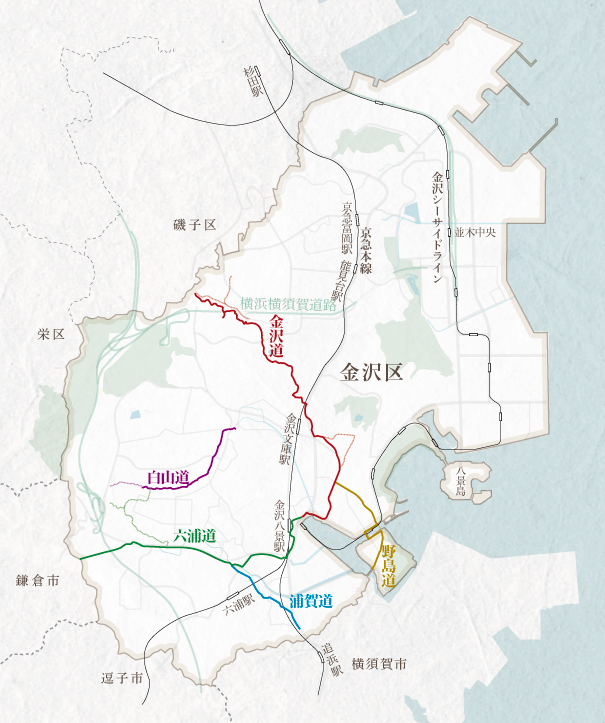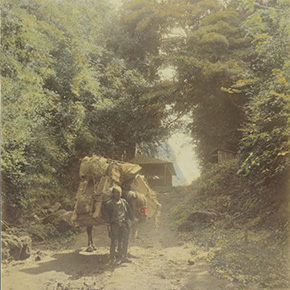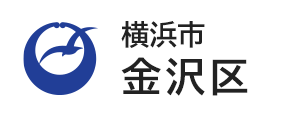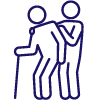- Yokohama-shi Top Page
- Kanazawa Ward Top Page
- Introduction of the ward
- History of Kanazawa Ward
- Yokohama Kanazawa, where history lives
- Kanazawa unraveled from the scenery
- Old Path in Kanazawa and Choinagiri-dori
Here's the text.
Old Path in Kanazawa and Choinagiri-dori
Last Updated November 6, 2020
Following the history of Kanazawa Ward, you can see that ancient roads have played an important role since then as arteries that connect local life such as Kamakura during the Kamakura period and Edo period and Uraga during the Edo period.
You may be able to feel the history of those days by visiting these roads, which are still widely used today.
(* Partially revised from Kanazawa's Old Path, published in Kanazawa Ward Office, 1984)

Rokuura Road (Kamakura Road)
Rokuura-do, a representative ancient road in the Middle Ages, was literally a road connecting Kamakura and Rokuuratsu.
Originally, this road is an arterial road opened based on the military and economic intentions of the Kamakura Shogunate.
Kanazawa is geographically and militaryly located in the Karamate of Kamakura, and was an important base for transportation to the Boso Peninsula and as an outer port.
Minato Rokuura and Choinagiri

Asaina Toge Baga (Kusuyama Nagao Collection, Kanazawa Bunko, Kanagawa Prefecture)
Choinagiri-dori, which is recorded that construction was started in 1241, is a road created by cutting mountains in order for the Kamakura Shogunate to open the main road (Rokuura Road) connecting Rokuura and Kamakura.
Kanazawa and Rokuura were good ports to prevent wind waves, so it became a base for logistics as an outer port of the Kamakura Shogunate.
When salt production began in Rokuura and Kamariya, salt was transported to Kamakura through Choinagiridori.
※"Asahina" has been used as a place name since ancient times, but the official name of the nationally designated historic site is "Asaina Kiridori".
Uraga Road
As stated in "Uraga Kaido reaches Urago-mura, Miura-gun from Hirabu-mura" and "New Edition Musashi Fudoki", this road is an old highway from Rokuura to Urago and to Uraga.
(Hirabun Village refers to the current three boats and most of Segasaki.)
The Edo Shogunate established a guardhouse in Shimoda in 1616 (1616) to manage ships entering Edo Bay, but abolished it due to the difficulties of wind waves, and in 1720 (1720) Uraga Magistrate's establishment I moved the guard.
In connection with this, the land route connecting Edo and Uraga, Uraga Road, will also increase its importance.
Kanazawa Road (Hodogaya Road)
The road from Tokaido Hodogaya-juku to Kanazawa through Nomi-do is called Kanazawa Road.
"Kamakura Monogatari" published in 1659 (1659) states as a course to Kanazawa Hakkei, a familiar holiday resort for Edo citizens.
"If you think you can't see it from Edo, come to Kanazawa from Katahira and go to Kamakura, it's better to see it."
In other words, the eight views of Kanazawa are positioned as a set with Kamakura and Enoshima. The peak as a scenic spot has been around the year of culture and Bunsei, and many publications such as Nomi-do, "Hakkei Guide Map" and "Ichimo-no-zu", which were auctioned and published by temples and travel agencies, were at that time. I'm telling you now.
Hakusan Road
It is not clear when the Hakusan Road was opened and when it came to be called Hakusan Road.
However, this road seems to have been opened at least in the middle of the Kamakura period.
It is presumed that the father of Kanazawa Hojo, Minoru Hojo, became the lord of Rokuurasho in 1108 (1224), and he was called Rokuuraden or Kamariyaden, because he had a residence around Kamariya.
What seems to be a part of that time is currently running in front of Teko Shrine-Toko-ji Temple-Shiroyama Shrine-Cliff Buddha.
Beyond that, it was destroyed or interrupted due to the construction of houses and roads, but it originally reached Kamakura.
Nojima Road
The road from Machiya Shrine to Kanazawa Elementary School to Nojima is the Nojima Road. Nojima was a convenient road as a transportation route to the Miura Peninsula by boat.
At the end of the Tokugawa period, in response to the successive invasion of foreign ships, we ordered the placement of various clans throughout the Miura Peninsula. Along with these, various round-trips to the Miura Peninsula were frequently used.
Inquiries to this page
Kanazawa Ward General Affairs Department Regional Promotion Division
Telephone: 045-788-7804
Telephone: 045-788-7804
Fax: 045-788-1937
Email address: kz-chishin@city.yokohama.jp
Page ID: 733-261-528













